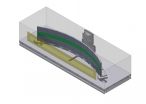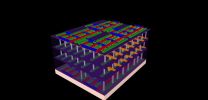INFORMATION:
The authors of this publication include the following faculty from the University of Granada: Julio José Ochoa Herrera, senior lecturer in Physiology (Research group CTS-627, Physiology and Biochemistry of Oxidative Stress) Jesús Florido Navío, senior lecturer in Obstetrics and Gynaecology (Group CTS-515: Advanced Aspects of Clinical Services for Women); Javier Díaz Castro, senior lecturer in Physiology (Group AGR-206: Food, Nutrition, and Absorption)
A 2-minute delay in cutting the umbilical cord leads to a better development of newborns
These are the conclusions of a study conducted by University of Granada scientists and the San Cecilio Clinical Hospital, published in the prestigious journal Pediatrics
2014-12-15
(Press-News.org) A study conducted by University of Granada scientists (from the Physiology, Obstetrics and Gynaecology Departments) and from the San Cecilio Clinical Hospital (Granada) has demonstrated that delaying the cutting of the umbilical cord in newborns by two minutes leads to a better development of the baby during the first days of life.
This multidisciplinary work, published in the prestigious journal Pediatrics reveals that the time in cutting the umbilical cord (also called umbilical cord clampling) influences the resistance to oxidative stress in newborns.
For this research, scientists worked with a group of 64 healthy pregnant women who went into labour in the San Cecilio Clinical Hospital in Granada. They all had a normal pregnancy and spontaneous vaginal delivery. Half of the newborns had their umbilical cord cut 10 seconds after delivery, whereas the other half had it cut after two minutes.
Beneficial effect
The results of this research suggest that there are beneficial effects in the late clampling of the umbilical cord: there was an increase in the antioxidant capacity of mature newborns and there was moderation of inflammatory effects in the case of induced delivery.
According to the PI in this project, University of Granada professor Julio José Ochoa Herrera, umbilical cord clamping is one of the most frequent surgical interventions practiced upon humans, and we have had proof of such practice for centuries. However, the right timing for clamping is controversial, and it involves important differences both for the mother and for the newborn.
This research led by the University of Granada compares for the first time the impact of the moment of clamping upon the oxidative stress and the inflammatory signal produced during delivery in both the mother and the newborn. "Our study demonstrates that late clamping of the umbilical cord has a beneficial effect upon the antioxidant capacity and reduces the inflammatory signal induced during labour, which could improve the development of the newborn during his or her first days of life", Ochoa concluded.
ELSE PRESS RELEASES FROM THIS DATE:
Live images from inside materials
2014-12-15
In medicine, X-rays provide high-resolution images of our insides to help doctors make a definitive diagnosis. Industry uses X-rays, too - as a reliable, non-destructive way of seeing what's hidden on inside materials and components and to check for cracks or irregularities. However industry additionally draws upon different technologies that are not used in the medical field. Whereas medical X-ray machines have been specifically designed for human test subjects, industrial X-ray machines are used to analyze objects that vary much more in their size and material composition. ...
Study: Novel agent decreases neuropathic pain in patients with type 2 diabetes
2014-12-15
MANHASSET, NY -- Molecular Medicine, a peer-reviewed biomedical journal published by the Feinstein Institute Press, published the results of a new study reporting clinically significant pain reduction in type 2 diabetic patients. In an exploratory study conducted by Araim Pharmaceuticals, a biotech company developing novel treatments for chronic diseases, investigators also observed improvements in metabolic control in patients administered ARA 290. ARA 290 is a peptide engineered to activate the innate repair receptor, a receptor discovered by Araim scientists, which is ...
Neurons listen to glia cells
2014-12-15
Scientists at Johannes Gutenberg University Mainz (JGU) in Germany have discovered a new signal pathway in the brain that plays an important role in learning and the processing of sensory input. It was already known that distinct glial cells receive information from neurons. However, it was unknown that these same glial cells also transmit information to neurons. The glia release a specific protein fragment that influences neuronal cross-talk, most likely by binding to the synaptic contacts that neurons use for communication. Disruption of this information flow from the ...
Attitudes to climate change depend on people's sense of belonging to the planet
2014-12-15
New research led by the University of Exeter has found that people who have a stronger sense of place at the global than the national level are more likely to accept that climate change is caused by human activities. This is the first time that acceptance of human causes of climate change has been shown to be linked to people's sense of place at the global level. The findings have significant implications both for climate change communications and for our understanding of place and identities.
The study 'My country or my planet? Exploring the influence of multiple place ...
'Genome editing' could correct genetic mutations for future generations
2014-12-15
BLOOMINGTON, Ind. -- Scientists at Indiana University and colleagues at Stanford and the University of Texas have demonstrated a technique for "editing" the genome in sperm-producing adult stem cells, a result with powerful potential for basic research and for gene therapy.
The researchers completed a "proof of concept" experiment in which they created a break in the DNA strands of a mutant gene in mouse cells, then repaired the DNA through a process called homologous recombination, replacing flawed segments with correct ones.
The study involved spermatogonial stem ...
Parkinson's patients identify balance and anxiety among top 10 research priorities
2014-12-15
Patients with Parkinson's, medics and carers have identified the top ten priorities for research into the management of the condition in a study by the University of East Anglia and Parkinson's UK.
Commissioned by Parkinson's UK, people with direct and indirect personal experience of the condition worked together to identify crucial gaps in the existing evidence to address everyday practicalities in the management of the complexities of Parkinson's. Patients stated that the overarching research aspiration was an effective cure for Parkinson's but whilst waiting for this ...
Signaling mechanism could be target for survival, growth of tumor cells in brain cancer
2014-12-15
DALLAS - Dec. 15, 2014 - UT Southwestern Medical Center neurology researchers have identified an important cell signaling mechanism that plays an important role in brain cancer and may provide a new therapeutic target.
Researchers found that this mechanism -- a type of signaling termed constitutive or non-canonical epidermal growth factor receptor (EGFR) signaling -- is highly active in glioblastomas, the most common type of adult brain cancer and a devastating disease with a poor prognosis.
When activated in cancer cells, it protects the tumor cells, making them more ...
Control on shape of light particles opens the way to 'quantum internet'
2014-12-15
In the same way as we now connect computers in networks through optical signals, it could also be possible to connect future quantum computers in a 'quantum internet'. The optical signals would then consist of individual light particles or photons. One prerequisite for a working quantum internet is control of the shape of these photons. Researchers at Eindhoven University of Technology (TU/e) and the FOM foundation have now succeeded for the first time in getting this control within the required short time. These findings are published today in Nature Communications.
Quantum ...
Stanford team combines logic, memory to build a 'high-rise' chip
2014-12-15
For decades, the mantra of electronics has been smaller, faster, cheaper.
Today, Stanford engineers add a fourth word - taller.
At a conference in San Francisco, a Stanford team will reveal how to build high-rise chips that could leapfrog the performance of the single-story logic and memory chips on today's circuit cards.
Those circuit cards are like busy cities in which logic chips compute and memory chips store data. But when the computer gets busy, the wires connecting logic and memory can get jammed.
The Stanford approach would end these jams by building layers ...
People with low numeracy feel negative about taking part in bowel cancer screening
2014-12-15
PEOPLE who have problems with numbers may be more likely to feel negative about bowel cancer screening, including fearing an abnormal result, while some think the test is disgusting or embarrassing, according to a Cancer Research UK supported study* published today (Monday) in the Journal of Health Psychology.
The researchers** sent information about bowel cancer screening to patients aged from 45 to 59 along with a questionnaire which assessed their numerical skills and attitudes to the screening test, which looks for blood in stool samples.
Almost 965 people - registered ...
LAST 30 PRESS RELEASES:
Exploring how the visual system recovers following injury
Support for parents with infants at pediatric check-ups leads to better reading and math skills in elementary school
Kids’ behavioral health is a growing share of family health costs
Day & night: Cancer disrupts the brain’s natural rhythm
COVID-19 vaccination significantly reduces risk to pregnant women and baby
The role of vaccination in maternal and perinatal outcomes associated with COVID-19 in pregnancy
Mayo Clinic smartwatch system helps parents shorten and defuse children's severe tantrums early
Behavioral health spending spikes to 40% of all children’s health expenditures, nearly doubling in a decade
Digital cognitive behavioral treatment for generalized anxiety disorder
Expenditures for pediatric behavioral health care over time and estimated family financial burden
Air conditioning in nursing homes and mortality during extreme heat
The Alps to lose a record number of glaciers in the next decade
What makes a good proton conductor?
New science reporting guide published for journalists in Bulgaria
New international study reveals major survival gaps among children with cancer
New science reporting guide published for journalists in Turkey
Scientists develop a smarter mRNA therapy that knows which cells to target
Neuroanatomy-informed brain–machine hybrid intelligence for robust acoustic target detection
Eight SwRI hydrogen projects funded by ENERGYWERX
The Lundquist Institute and its start-up company Vitalex Biosciences Announces Strategic Advancement of Second-Generation fungal Vaccine VXV-01 through Phase 1 Trials under $40 Million Competitive Con
Fine particles in pollution are associated with early signs of autoimmune disease
Review article | Towards a Global Ground-Based Earth Observatory (GGBEO): Leveraging existing systems and networks
Penn and UMich create world’s smallest programmable, autonomous robots
Cleveland researchers launch first major study to address ‘hidden performance killer’ in athletes
To connect across politics, try saying what you oppose
Modulating key interaction prevents virus from entering cells
Project explores barriers to NHS career progression facing international medical graduates
Jeonbuk National University researchers explore the impact of different seasonings on the flavor perception of Doenjang soup
Two Keck Medicine of USC Hospitals named Leapfrog Top Teaching Hospitals
World-first discovery uncovers how glioblastoma tumours dodge chemotherapy, potentially opening the door to new treatments
[Press-News.org] A 2-minute delay in cutting the umbilical cord leads to a better development of newbornsThese are the conclusions of a study conducted by University of Granada scientists and the San Cecilio Clinical Hospital, published in the prestigious journal Pediatrics


